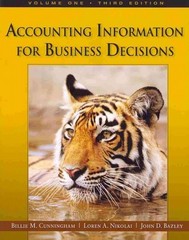Question
Q17 (a)In what circumstances may a taxpayer claim depreciation deductions under subpart EE? (b)Explain the different ways property can be depreciated for tax purposes. (c)
Q17
(a)In what circumstances may a taxpayer claim depreciation deductions under subpart EE?
(b)Explain the different ways property can be depreciated for tax purposes.
(c) A commercial building owner upgrades and replaces the building's air conditioning system. Can the new air conditioning unit be depreciated?
(d) A business acquires some new office equipment - a desk for $400, two chairs for $280 each and a small filing cabinet for $100. All of the equipment is purchased at the same time from the same supplier. Can the cost of these assets be immediately expensed or must the cost be depreciated?
(e) A business has some equipment that originally cost $2,000. Depreciation of $800 has been claimed. The equipment is stolen, and the business makes a claim under its insurance policy and receives $600. Is there any gain or loss calculated for depreciation purposes in the year the equipment is stolen?
(f) A business has some old office equipment in storage that is no longer being used. The office equipment has an adjusted tax value of $800. The business has asked if any staff members would like to purchase any of the equipment, but have not received any interest. The business wants to write off the remaining adjusted tax value of the equipment. What does the business need to demonstrate in order to claim the writeoff?
Q18
Part (a)
Some business-related entertainment expenses are 100% deductible. Others are set as 50% deductible because they have a significant private element. Explain how much of the following expenses can be deductible for tax purposes:
(i)Catriona is self-employed and travels to Queenstown to attend a meeting with business clients. Because no other accommodation is available she stays at a holiday home while in Queenstown for the meeting.
(ii)Eileen is a business owner and hires a large yacht to take her management team out on the harbour for a planning day.
(iii)ABC Ltd puts on a Christmas party for its employees. It holds the party at work.
(iv)EFG Ltd provides morning and afternoon teas for its employees
(v)Hannah invites a supplier to a business lunch at a local restaurant and her business pays the bill, which comes to $160.
(vi)Real estate agent Bob delivers a bottle of champagne tothe owner each time he arranges the sale of a house. Hecan only deduct 50% of the cost of the bottle of champagne as he is providing entertainment away from his business premises in the form of drink. Bob also sends a gift basket containing a bottle of wine, some cheese and various household items such as tea towels and soaps to the purchaser.
(vii)Once a month, the senior managers at XYZ Ltd meet in their executive dining room to review the month's production figures and light meal of sandwiches and fruit and fruit are provided
(viii)FGH Ltd provides entertainment to promote a business or the business's products or services to the public.
(ix)A restaurant provides a free meal to a food critic who will writes a review of the restaurant for their newspaper column.
(x)Every Tuesday night, a restaurant offers half-price meals to the general public. The restaurant can deduct 100% of the cost of these meals.
(xi)A building firm donates food to a Christmas party at a children's hospital. The expense is 100% deductible.
(xii)RST Ltd holds a business-planning conference in Perth, Australia. The costs are 100% deductible because the entertainment is held outside New Zealand. RST Ltd also provides entertainment for employees and clients on a recreational fishing boat. The boat travels 20 km from the North Island.
(xiii)Bernadette buys Christmas lunch for all her five employees. Each person's lunch costs $42 and they each contribute $10 (the extra benefit).
(xiv)Kiz Ltd provides $5,000 of sponsorship to a local netball team, who wear outfits with the Kiz logo on it, giving the company brand exposure. In return, Kiz Ltd gets tickets worth $590 to the team's corporate box. This is the extra benefit. Instead of deducting the full $5,000, Kiz Ltd must take into account 50% of the tickets' price.
(xv)This month, Patrick delivered some impressive results at work. His employer Jillian gives him a $100 gift voucher. Because Patrick can spend the voucher how he likes,
Part (b)
The following are details of vehicle usage and related expenditure:
Log Book for 90 consecutive days:
Odometer reading start period = 40,000 km
Odometer reading end period = 62,000 km
Total travelled for 90 consecutive days = 62,000 - 40,000 = 22,000
Business travel for 90 consecutive days = 7500 Km
Motor Vehicle Expenditure: 2017/2018
Repairs & maintenance = $5,000
Petrol Consumption = $4,000
Depreciation =$ 2,000
Total = $11,000
Total Km travelled in 2017/2018 = 65,800 KM (including 25,100 KM for business purpose)
Motor Vehicle Expenditure: 2018/2019
Repairs & maintenance = $7,000
Petrol Consumption = $5,000
Depreciation =$ 2,000
Total = $14,000
Total KM travelled in 2018/2019 = 78,000 KM (31,200 Km for business purpose)
Required:
Calculate the total vehicle usage expenditure that can be claimed under each of the following methods for the 2017/2018 and 2018/ 2019 tax periods:
(i)The cost method using actual records
(ii)The cost method using a logbook
(iii)The kilometre method
Step by Step Solution
There are 3 Steps involved in it
Step: 1

Get Instant Access to Expert-Tailored Solutions
See step-by-step solutions with expert insights and AI powered tools for academic success
Step: 2

Step: 3

Ace Your Homework with AI
Get the answers you need in no time with our AI-driven, step-by-step assistance
Get Started


